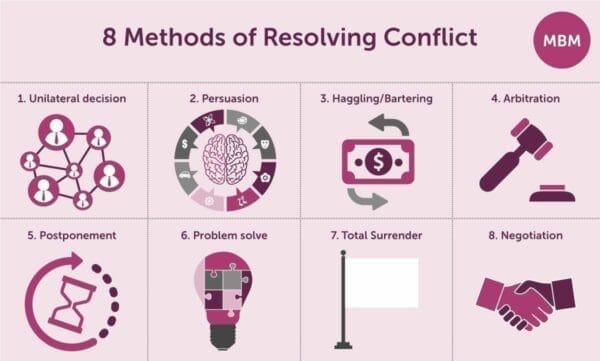
Conflict Resolution Strategies for Peaceful Resolutions

Strategies for Peaceful Resolutions
In the workplace, conflicts are inevitable. Whether they stem from differing opinions, personalities, or priorities, knowing how to handle conflicts effectively is essential for maintaining a harmonious and productive environment.
Understanding the Nature of Conflict
Conflict is a natural part of human interaction and can arise from a variety of sources. It may be rooted in misunderstandings, competing interests, or unresolved issues. By understanding the underlying causes of conflict, you can approach resolution with empathy and clarity.
Creating a Culture of Open Communication
Open communication is the cornerstone of conflict resolution. Encourage team members to voice their concerns openly and honestly, and foster an environment where differing viewpoints are valued and respected. By promoting transparency and dialogue, you lay the groundwork for resolving conflicts constructively.
Active Listening and Empathy
Effective conflict resolution requires active listening and empathy. Take the time to listen to all parties involved, seeking to understand their perspectives and emotions. Empathize with their experiences and validate their feelings, demonstrating that you value their input and are committed to finding a solution that meets everyone’s needs.
Seeking Common Ground
In many cases, conflicts arise from a clash of interests or priorities. Look for areas of common ground or shared goals that can serve as a foundation for resolution. By focusing on shared objectives, you can shift the conversation away from differences and towards collaborative problem-solving.
Exploring Multiple Perspectives
Encourage a diversity of perspectives when approaching conflict resolution. Invite input from all parties involved, including those who may not be directly affected by the conflict but whose insights can provide valuable perspective. By considering a range of viewpoints, you can uncover creative solutions that address underlying issues effectively.
Maintaining Neutrality and Fairness
As a mediator or facilitator of conflict resolution, it’s essential to remain neutral and impartial. Avoid taking sides or playing favorites, and strive to maintain fairness and objectivity throughout the process. By establishing yourself as a neutral party, you create an environment where all parties feel heard and respected.
Using Collaborative Problem-Solving Techniques
Collaborative problem-solving techniques can be highly effective in resolving conflicts. Encourage brainstorming, idea generation, and consensus-building among all parties involved. By involving everyone in the process of finding a solution, you promote ownership and buy-in, increasing the likelihood of successful resolution.
Managing Emotions and Diffusing Tension
Conflicts can often evoke strong emotions, ranging from frustration and anger to sadness and fear. As a mediator, it’s essential to manage emotions effectively and help diffuse tension when necessary. Encourage constructive communication, and intervene if discussions become heated or unproductive.
Implementing Conflict Resolution Strategies
Once a resolution has been reached, it’s important to implement and follow through on agreed-upon solutions. Clearly communicate expectations and timelines, and ensure that all parties are committed to upholding their end of the agreement. Regularly monitor progress and address any issues that arise promptly.
Learning and Growing from Conflict
Conflict, when handled effectively, can be a catalyst for positive change and growth. Encourage reflection and feedback following the resolution process, and identify lessons learned that can be applied to future situations. By embracing conflict as an opportunity for learning and improvement, you foster a culture of resilience and continuous improvement within your team. Read more about tips for handling conflict


